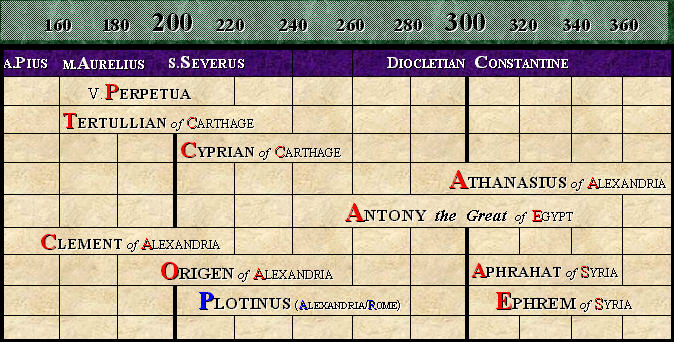|
|
CONSTANTINE (Emperor 306-337)
Colossal
Bust of Constantine |
|
|
CONSTANTINE (Emperor 306-337)
Colossal
Bust of Constantine |
CONSTANTINE the Great (d. 337), Roman emperor. The date of his birth is unknown; it has been variously placed between 274 and 288. The son of the Emperor Constantius Chlorus and St. Helena, he was sent in 292 to the court of Diocletian, the senior emperor, under whose influence he learned the new Byzantine ideas of absolute sovereignty, which were rapidly replacing the Roman conception of the principate.
|
|
|
|
The
First Tetrarchy: Diocletian, Maximian, Galerius, and Constantius. ca.300 |
Christ Depicted as Helios, the Sun-God. mosaic, early 290s |
In 306, on the death of Constantius, he was proclaimed Emperor at York, and became senior ruler of the empire in 312, after defeating his rival Maxentius at the Milvian Bridge.
|
|
|
|
Christ the Sun-God, Mosaic, 380s |
Chi-Rho on
Christian Sarcophagus early 300s |
At that battle Constantine adopted the Labarum standard, as the champion of Christianity, and shortly afterwards toleration and Imperial favour were given to the Christian faith, though whether there was ever a formal and comprehensive proclamation, such as the supposed Edict of Milan, is a matter of disagreement among historians.
|
|
|
Constantine's Victory at the Milvian Bridge in 312, Triumphal arch, 380s |
Since Constantine’s policy was to unite the Christian Church to the secular State by the closest possible ties, it was natural that even before he formally professed Christianity himself he should be concerned with the internal affairs of the Church.
In 313 the Donatist schismatics in Africa appealed to him to settle their controversy with the Church of that province, and at their request he referred the matter first to a commission of bishops, then to a synod of Gaul and Italy (Arles, 314), and finally in 316 heard the case himself. In each trial the verdict went against the Donatists, who thereupon attacked not only their ecclesiastical opponents but also the State, encouraging rioting and brigandage. Constantine was therefore constrained to reinforce his verdict with repressive measures.
|
|
|
|
Constantine
Crowns Pope Sylvester MS illum. Cologne, 1332 |
Bishop
Maximian’s ivory throne, c. 550 |
A similar appeal from the contending parties led Constantine to summon the Council of Nicaea (325) to settle the Arian dispute about the Person of Christ. The Emperor himself presided, though unbaptized, a circumstance which foreshadows the Byzantine theory of the emperors as supreme rulers of Church and State alike. The victory of orthodoxy which the creed of the council symbolizes did not prevent Constantine from banishing prominent orthodox leaders in later years (e.g. St. Athanasius in 336) at the instance of their enemies. Constantine’s ecclesiastical advisers included men of various beliefs, esp. Hosius, Bishop of Cordova, Eusebius, Bishop of Caesarea, and Lactantius.
The breach with the old traditions of Rome was complete when, after the victory at Chrysopolis (324) which had made him sole emperor, Constantine fixed his capital at Byzantium (rebuilt and inaugurated as ‘Constantinople’ in 330).
|
|
|
| Modern "Istanbul" (="Constantinople") | Constantinople on the Bosphorus |
|
|
| Ancient Constantinople |
|
|
| Ancient Constantinople |
|
|
|
|
The
Walls of Byzantium, Imperial capital from 324; renamed Constantinople in 330 |
Constantine |
Throughout his reign he did his best to conciliate both pagans and Christians, and it is difficult to say when he first decided to embrace Christianity. He was not baptized until just before his death, but deferment of baptism was common in those days. and his policy and legislation, though not free from grave blemishes, show a strongly Christian tendency from the first.
He humanized the criminal law and the law of debt, mitigated the conditions of slavery, made grants to support poor children, thus discouraging the exposure of unwanted babies, freed celibates and unmarried persons from special taxation, legislated against incontinence, and exempted Christian clergy from the burden of the decurionate. In 321 he ordered that Sunday should become a public holiday. He liberally endowed Christian church building, esp. at the Holy Places in Palestine.
|
|
|
| The Empress Helena, 380 | The Church of the Nativity, Bethlehem |
If the centralization of the empire at Constantinople led to an increasing Imperial control of the Eastern Church, it had also the consequence, perhaps unforeseen, of making the bishops of Rome more prominent than any other figure, lay or ecclesiastical, in the West; and it is from the 4th cent. that the Papacy begins to assume its secular importance and the position which it held in the Middle Ages.
|
|
|
|
Constantine's gift of the Lateran Basilica in Rome |
Emperor Julian the Apostate, 362 |
Legend has added much to history. A tradition going back to the 5th cent. asserts that he was baptized at the Lateran by Pope Sylvester, and his connections with the Pope are further embellished in the [spurious] Donation of Constantine. In the Eastern Church he has been named the ‘Thirteenth Apostle’ and is venerated as a saint. Feast day in the East, 21 May (with St. Helena).

xxxx» cont
xcxcxc